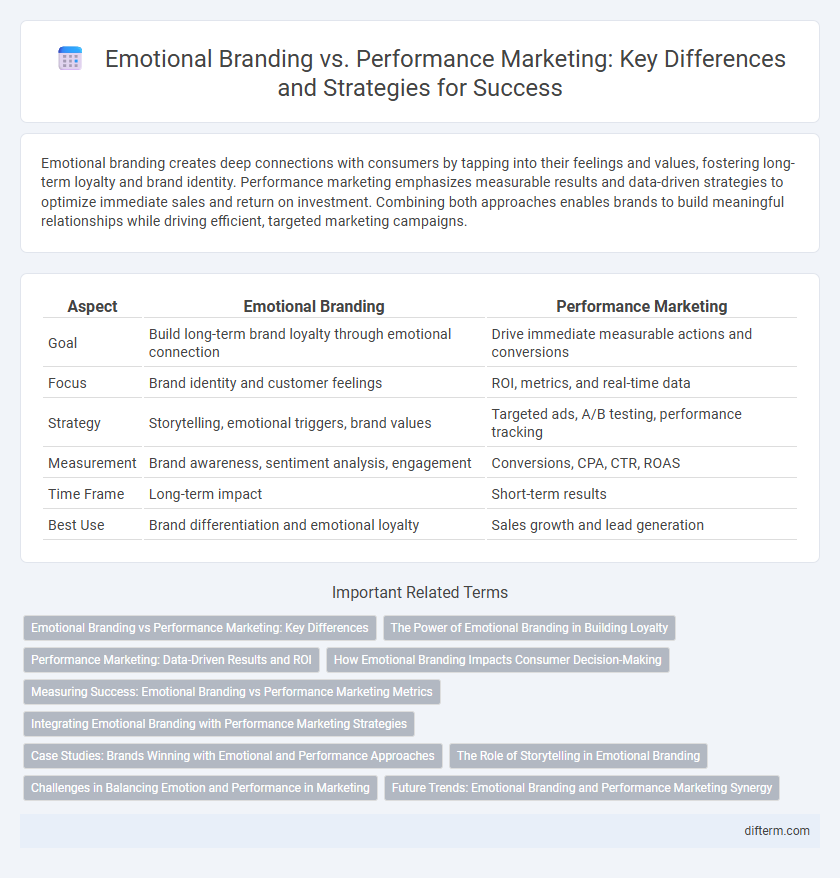Emotional branding creates deep connections with consumers by tapping into their feelings and values, fostering long-term loyalty and brand identity. Performance marketing emphasizes measurable results and data-driven strategies to optimize immediate sales and return on investment. Combining both approaches enables brands to build meaningful relationships while driving efficient, targeted marketing campaigns.
Table of Comparison
| Aspect | Emotional Branding | Performance Marketing |
|---|---|---|
| Goal | Build long-term brand loyalty through emotional connection | Drive immediate measurable actions and conversions |
| Focus | Brand identity and customer feelings | ROI, metrics, and real-time data |
| Strategy | Storytelling, emotional triggers, brand values | Targeted ads, A/B testing, performance tracking |
| Measurement | Brand awareness, sentiment analysis, engagement | Conversions, CPA, CTR, ROAS |
| Time Frame | Long-term impact | Short-term results |
| Best Use | Brand differentiation and emotional loyalty | Sales growth and lead generation |
Emotional Branding vs Performance Marketing: Key Differences
Emotional branding centers on creating deep, long-lasting connections between consumers and brands by appealing to feelings, values, and identity, fostering loyalty and brand advocacy. In contrast, performance marketing focuses on measurable results, such as clicks, conversions, and sales, using data-driven strategies to optimize return on investment (ROI) in real time. While emotional branding builds brand equity over time, performance marketing delivers immediate, quantifiable outcomes, making them complementary yet distinct marketing approaches.
The Power of Emotional Branding in Building Loyalty
Emotional branding leverages deep psychological connections to create strong brand loyalty by resonating with customers' values and experiences. Unlike performance marketing, which focuses on immediate conversions and measurable metrics, emotional branding builds long-term trust and advocacy through storytelling and authentic engagement. Brands that effectively utilize emotional branding see increased customer retention and lifetime value, driving sustainable growth beyond short-term sales.
Performance Marketing: Data-Driven Results and ROI
Performance marketing leverages data analytics to optimize campaigns for measurable results and higher return on investment (ROI). By focusing on targeted advertising, conversion tracking, and real-time adjustments, it ensures budget efficiency and maximizes customer acquisition. This approach prioritizes direct outcomes over brand sentiment, making it ideal for businesses aiming for immediate growth and accountability.
How Emotional Branding Impacts Consumer Decision-Making
Emotional branding creates deep connections by appealing to consumers' feelings, memories, and aspirations, which enhances brand loyalty and long-term engagement. This approach influences consumer decision-making by tapping into subconscious motivations and fostering trust, making customers more likely to choose a brand even in competitive markets. Brands leveraging emotional branding see higher customer retention and increased lifetime value compared to performance marketing focused solely on short-term sales metrics.
Measuring Success: Emotional Branding vs Performance Marketing Metrics
Emotional branding measures success through brand loyalty, customer engagement, and long-term emotional connections, often tracked via sentiment analysis and brand recall surveys. Performance marketing relies on quantifiable metrics such as conversion rates, cost per acquisition (CPA), return on ad spend (ROAS), and click-through rates (CTR) to assess campaign effectiveness. Combining these approaches enables marketers to balance immediate ROI with sustained brand equity growth.
Integrating Emotional Branding with Performance Marketing Strategies
Integrating emotional branding with performance marketing strategies enhances customer engagement by combining deep brand connections with measurable campaign results. Emotional branding builds lasting loyalty and trust, while performance marketing drives immediate conversions through data-driven tactics. This synergy maximizes ROI by aligning brand values with targeted audience actions across multiple channels.
Case Studies: Brands Winning with Emotional and Performance Approaches
Case studies of brands like Nike illustrate the power of emotional branding by creating deep customer connections through storytelling and shared values, resulting in increased loyalty and brand equity. In contrast, performance marketing exemplified by Amazon leverages data-driven campaigns and measurable ROI to boost sales and optimize ad spend efficiently. Brands combining emotional branding with performance marketing strategies, such as Coca-Cola, achieve both strong brand affinity and high conversion rates, maximizing overall marketing effectiveness.
The Role of Storytelling in Emotional Branding
Storytelling in emotional branding creates deep connections by conveying authentic narratives that resonate with consumers' values and experiences, enhancing brand loyalty and long-term engagement. Emotional branding leverages powerful stories to evoke feelings that transcend transactional relationships, contrasting with performance marketing's focus on immediate, measurable actions like clicks and conversions. This strategic use of storytelling differentiates brands in crowded markets by humanizing them and driving sustained emotional investment.
Challenges in Balancing Emotion and Performance in Marketing
Balancing emotional branding with performance marketing poses challenges such as aligning long-term brand loyalty goals with immediate conversion metrics, which often demand different strategies and KPIs. Emotional branding requires deep storytelling and customer connection, while performance marketing emphasizes data-driven tactics and measurable ROI. Marketers must integrate qualitative emotional insights with quantitative performance data to optimize campaigns that resonate emotionally yet deliver tangible results.
Future Trends: Emotional Branding and Performance Marketing Synergy
Future trends in marketing reveal a growing synergy between emotional branding and performance marketing, leveraging data-driven insights to create personalized, emotionally resonant consumer experiences. Integrating AI and advanced analytics enhances brand storytelling by targeting consumers' values and emotions while optimizing conversion rates through real-time performance metrics. This hybrid approach drives stronger customer loyalty and measurable ROI, redefining marketing strategies for heightened engagement and sustainable growth.
Emotional branding vs performance marketing Infographic

 difterm.com
difterm.com